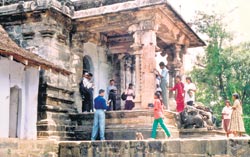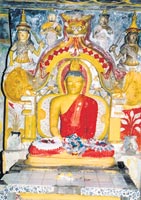
Synthesis of Buddhist-Hindu worshipGadaladeniya Raja Maha Viharaya in Udunuwara in the Kandy district dates back to the reign of King Bhuvanekabahu IV of Gampola. The other shrines of the period in close proximity are Lankathilaka Raja Maha Viharaya and Embekke Devalaya. These shrines possess common features showing Buddhist-Hindu worship. Gadaladeniya Raja Maha Vihara can be reached by road from Embilmeegama junction close to the Pilimatalawa town. Turn off at the 56th mile post and proceed along the winding road to Daulagale for half a mile to reach the vihara premises.
Gadaladeniya vihara stands on the border of Udunuwara and Yatinuwara.The vihara was known in the past by different names such as Gadaladeniya Viharaya, Gadaladeniya Gramaye Viharaya, Gadaladeniya Gramaye Saddharamakirthi Viharaya and Dhamakirthi Viharaya.The present name Gadaladeniya Raja Maha Viharaya is after the village Gadaladeniya.The village also came to be called Diggalagala because of the rocky nature of the terrain. The inscription at the vihara premises mentions the date on which the vihara was built. According to this information, it was built by a bhikku named Dharmakirthi on April 28, 1344 AC. The venerable thera built two other viharas -Sri Dhamiyakal Viharaya in Amarawathi in India and Alavatura Viharaya in the Kegalle district. The bhikku had visited south India and was influenced by Hindu architecture. On his return, he made use of Hindu architecture which was familiar to him when designing Gadaladeniya Viharaya. The viharaya was restored during the reign of King Parakrama Bahu VI of Kotte. Later King Veera Parkrama Bahu Narendrasinghe of Kandy gifted the viharaya to Ven.Welivita Sri Saranankara Sangaraja Maha Thera. The village was built on granite and the Buddha image was carved out of the same material to last for a longer period. The rock was found freely in the vicinity. There had been a roof above the shrine temporarily put up to protect the building from the elements. The roof rested on brick pillars and was paved with the flat tiles. The structure of the roof appeared like a Pahankuduwa and had the resemblance of a design with a spiral tapering upwards to form a pinnacle at the top.
Two other buildings the Digge and Bera maduwa were built with stone and clay and plastered with lime and sand. At the entrance to the shrine is Sandakadapahana (moonstone). The floor is paved with cowdung and clay. The bera maduwa is meant for the drummers to perform their thevava at different times of the day when offerings are made. The devalaya of the Gadaladeniya Vihara was dedicated to God Upulavan (Varuna) when it was built and this is mentioned in the inscription. But when the worship of Vishnu became popular, devotees began to pay their obeisance to God Vishnu, relegating the worship of God Upulavan. The Buddha image inside the main shrine room has the dhiyama mudra (highest level in meditation). The sedant Buddha image is built with brick and mortar and plastered with lime and sand. The robe is painted red in colour and the body of the image is painted in gold. The eyes remain wide open similar to the features of south Indian Buddhist sculpture. The neck and brow are clearly marked with wrinkles. The image does not show any sign of the serenity and calmness seen in Buddha images of the early period. The image is the best example of the style of the Buddhist sculpture of the Gampola period. The makara thorana above the Buddha statue has small images with their hands raised in adoration. The images as described in the Gadaladeniya inscription represent Salerea, Brahma, Suyama, Santhusthika, Natha and Maithri. The two standing Buddha images on the side of the main Buddha figure also belong to the Gampola period. The main Buddha image is placed on a pedestal known as the asana. The mal asana where flowers are kept as offerings is decorated with creepers and line work resembling floral designs. These are the works of folk artists of the Kandyan period. The sculpted figures of dancers, drummers, raban players, flutists and wrestlers are some of the interesting carvings on stone. On the borders are lotus petal design. The main Buddha image is erected on a pedestal ( asana) on which the devotees made their offerings. The mal asana is decorated with creepers and line work resembling floral design. There are figures of dwarfs (vamana rupa) in different postures carved on the rock surface. The joint three sided stone twin pillars of the Mandapaya cannot be found anywhere other than in Yapahuwa. Ananda Coomaraawamy had described the carvings on these pillars in great detail. The influence of Pandayan and Vijaynagar stone carvings had helped to evolve the architectural design of Gadaladeniya Raja Maha Viharaya. |
|| Front
Page | News | Editorial | Columns | Sports | Plus | Financial
Times | International | Mirror | TV
Times | Funday
Times | Kandy
Times || |
| |
Copyright
2007 Wijeya
Newspapers Ltd.Colombo. Sri Lanka. |

